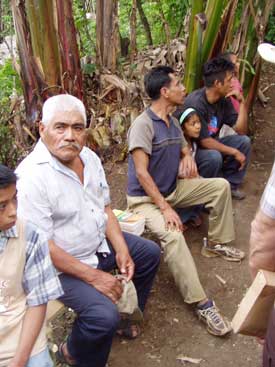Xilitla municipality
 After having driven several more miles through the mountains of the Huasteca that Sunday afternoon, we came to our next stop: the meeting-place of the congregation in the small Aztec town of Tlapexmecayo. We were quite grateful to the Christians there for waiting on us, since we were running behind. They were most gracious for waiting to have their worship service when we arrived, even though we had previously worshiped with the El Cañón congregation.
After having driven several more miles through the mountains of the Huasteca that Sunday afternoon, we came to our next stop: the meeting-place of the congregation in the small Aztec town of Tlapexmecayo. We were quite grateful to the Christians there for waiting on us, since we were running behind. They were most gracious for waiting to have their worship service when we arrived, even though we had previously worshiped with the El Cañón congregation.
When we arrived, we were heartily greeted by the preacher there, and we were soon led to the meetingplace. Even though this group of Christians did not have a building, they were content to meet under a pavilion, under which there was only enough room for about half of them. The rest stood or sat on benches, and the preacher led the service from under the pavilion.
One thing I noticed was that the preacher did nearly the whole service, except for one of the prayers which he asked brother José to lead (which he did entirely in Nahuatl, I may add!). Apparently the men present didn’t know how to lead various parts of worship, or weren’t confortable with it. Of course for all I know they were relatively new Christians!
Although I don’t remember the sermon topic, it was sound and biblical, as well as bilingual. It was actually a bit difficult for me to follow the preacher, since he kept switching between Nahuatl and Spanish. I noticed that he used a good number of Spanish words in his Nahuatl (mostly religious words), and upon asking him afterwards I learned that these are actually loanwords from Spanish, understood by all the Nahuatl speakers.
Communion was served, and after the sermon we sang the rousing song Estad por Cristo Firmes, of which I sang the bass line, not entirely alone (the English version of this song is entitled “Stand Up, Stand Up for Jesus.”).
After worship, they insisted that we eat a meal with them, notwithstanding the fact that we had already eaten just a few hours before. We were happy to have an early supper, however, and we certainly appreciated their great hospitality. The fare was pretty standard: rice with tortillas, as well as chicken and French fries.
 After eating, I asked the preacher a few things about Nahuatl, as aforementioned. Unfortunately, I was having difficulty understanding what he was saying, so I was glad when our translator Jesús came to the rescue to help explain things to me. I’ve found that I can understand some people better than others when they speak Spanish, so right now it’s just a matter of getting more familiar with the language.
After eating, I asked the preacher a few things about Nahuatl, as aforementioned. Unfortunately, I was having difficulty understanding what he was saying, so I was glad when our translator Jesús came to the rescue to help explain things to me. I’ve found that I can understand some people better than others when they speak Spanish, so right now it’s just a matter of getting more familiar with the language.
After a while it was time to return to the hotel in Ciudad Valles, and we hit the bumpy road once again. Great was our joy and contentment when we finally came to the paved highway, and I think we were all grateful for the relatively good condition of the roads in Texas.
Post-script: At every place we visited, I made it a point to ask what that place’s name meant. In the case of Tlapexmecayo, the name means “place of reeds,” harking back to the days when they used to make reed baskets there.